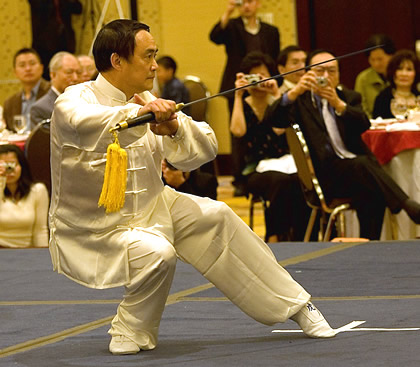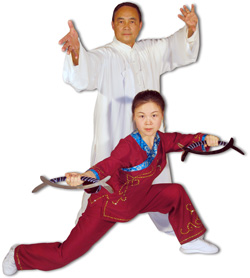By Wen-Ching Wu
 At 6:30 p.m, the lovely voice of the Chinese-speaking Mistress of Ceremonies came across the loud speakers, requesting that everyone take their pre-assigned seats. That request was followed by the voice of the charismatic English-speaking Master of Ceremonies translating the same. Even though the doors opened at 6:00 p.m., many guests had arrived two hours early and anxiously awaited the evening's demonstration and festivities. No wonder it took only a few minutes for 600 guests to settle at their respective tables.
At 6:30 p.m, the lovely voice of the Chinese-speaking Mistress of Ceremonies came across the loud speakers, requesting that everyone take their pre-assigned seats. That request was followed by the voice of the charismatic English-speaking Master of Ceremonies translating the same. Even though the doors opened at 6:00 p.m., many guests had arrived two hours early and anxiously awaited the evening's demonstration and festivities. No wonder it took only a few minutes for 600 guests to settle at their respective tables.
A brief introduction and welcoming remarks marked the beginning of two hours of non-stop demonstrations of the numerous styles of Wushu. Included were Changquan, Taijiquan, Xingyiquan, Baguazhang, Liuhebafa, Xiaoyaoquan, Iron Shirt, Sanshou, and numerous weapons. Without missing a beat, the demonstrations flowed from one extraordinary form to the next. It was like watching a real-life action movie! No camera tricks, no special effects, no suspended wires, just real people demonstrating their amazing Wushu skills. The audience forgot about time and place. It was as though they had been transported back into an ancient gathering of Wushu masters in an epic struggle for martial supremacy.
Two and a half hours flashed before their eyes. The flying jumps, flashing swords, powerful sabers, and whirlwind staffs were wielded with dynamic expression of External Wushu power. The subtle but energy-filled Internal Wushu and Hard Qigong filled the air of the huge ballroom with an ether-like force. The alternating performances of Internal and External Wushu captivated and mesmerized the attentive audience.
The 150 SYL Wushu, Taiji, Qigong Institute instructors and students, ranging in ages from six to eighty years old, masterfully executed examples of perfect hand and eye coordination, fluid body movement, and agile foot work. Each expressed a spirit filled with energy and power in perfect harmony. The audience feasted on all the major elements of Wushu in one evening, from the obvious ti (kicking techniques), da (hand and arm striking techniques), shuai (take down techniques), and na (controlling techniques), to Tiebushan (Iron Shirt), and Qinggong (Light Body and Agility). Many people exclaimed after the demonstration, "It was a world class performance by one of the best Wushu schools in the world."
Following the performances of the SYL Institute, masters of the International Wushu Sanshou Dao (IWSD) Association performed for the already-electrified audience. These masters came from China, Malaysia, Hong Kong, Russia, Taiwan, Singapore, the United States, and Canada. Their performances amazed the audience with demonstrations even more highly-skilled Wushu.

The final performance was by Grandmaster Liang. He stepped on the stage and dazzled the audience with a spectacular Liuhebafa sword routine, showing perfect harmony of his body with his mind, his mind with his intent, his intent with his qi, his qi with his spirit, his spirit with his movements, and his movements with the void (emptiness).
Grandmaster Liang received a standing ovation for several minutes before the audience was urged to sit down and allow the evening's festivities, including a grand banquet, to continue.
This historic event in the annals of Wushu happened May 20, 2007. It was a gathering of over seventy elite Wushu masters in one evening, to celebrate the 20th anniversary of two leading Wushu organizations, both guiding forces in the advancement and promotion of Wushu around the world. These are the SYL Wushu, Taiji, Qigong Institute and the IWSD. Attendees also included politicians, community and business leaders, Wushu masters, friends, and students from China, South America, the United States, Singapore, and Canada. The celebration converged at the Hyatt Regency Hotel located in picturesque downtown Vancouver.
Vancouver is a multicultural city that fosters diversity and has always been home to numerous Chinese pioneers. In 1982 it added another pioneer to the list, Shouyu Liang. In 1979 he was recognized and awarded the prestigious, "Coaches of Excellence" Award, given to the most outstanding coaches in China. His journey to Canada began in 1981 with a trip from Sichuan, China, to visit his uncle in Seattle, Washington. This was followed by many chance encounters that prompted him to immigrate to Canada. In 1983, he was formally appointed to the Physical Education and Recreation Department of the University of British Columbia (UBC). In 1985, he was elected as the National Coach of the first Canadian National Wushu Team and led the team to third place overall, trailing only China and the United States. The news of these outstanding accomplishments soon spread throughout China, Canada, and the United States.
Grandmaster Liang was the first professional Wushu coach to immigrate and teach in North America since the establishment of the People's Republic of China in 1949. His personal accomplishments and his ability to nurture and bring out the potential of his students were recognized over and over again in China, as well as his new home.
In 1987, during the fourth year of Liang's tenure at the University of British Columbia, the head of the Physical Education and Recreation Department suggested he branch out and promote Wushu to more Canadians by teaching outside of the University. With the help of the University of British Columbia, friends, and students, he established the Shouyu Liang (SYL) Wushu Institute in Vancouver. The first group of students was drawn from the University of British Columbia and the North American Taichi Association, of which Liang was the head coach and honorary chairman.
Also in 1987, Ma Fulin, head coach of the Heilongjiang Wushu Institute and the chief editor of the Jingwu (martial arts) Magazine, visited Liang in Vancouver. They conducted a series of discussions regarding the promotion of Wushu outside of China. Both were concerned by the lack of martial skills in many of the younger Wushu practitioners. They were also concerned by the separation of forms training and Sanshou (sparring) training.

The ten years of the Cultural Revolution from the mid-1960s to the mid-1970s forbade the teaching and training of many long-standing cultural traditions, including the teaching of the practical applications of Wushu. For this reason, government-sponsored Wushu teams focused on the flashy and showy side of Wushu. When Chinese Wushu teams performed in North America in the seventies and eighties, they demonstrated spectacular and incredible mastery of acrobatic abilities. Their kicks were high and powerful. Their body movements were connected and superb. Their foundations were solid. However, fighting skills were downplayed. When asked about fighting applications and/or when challenged by local martial artists, both performers and coaches avoided the subject, fearing that it would bring bad publicity. Because of this, many people outside of China were only exposed to the non-combative side of Wushu and didn't perceive Wushu as an effective martial art.
When Chinese policy began to allow the combative aspect of Wushu to be taught, many professional and amateur Wushu schools in China would only focus on either performance Wushu or Sanshou, but not both. This created a separation in Wushu, taking it away from its original nature which included practical applications, along with forms training and many other elements of Wushu.
Liang's love and respect for Wushu, along with his desire to continue the traditional legacy of Wushu with younger generations, was further ignited by the series of discussions with Ma Fulin. They agreed that in order to properly promote Wushu, an organization with a common goal that included as many like minded martial artists as possible was necessary. That goal would consist of nurturing the development of well-rounded martial artists by transcending the boundaries between styles to allow for the development of a highly practical and versatile system of martial skills. With this mission in mind, Liang contacted numerous masters of various martial arts disciplines throughout the world. Together they established the International Wushu Sanshou Dao (IWSD) Association.
The IWSD draws from an immense wealth of knowledge in Chinese Wushu, but is by no means limited to Chinese Wushu. All viable skills and knowledge from non-Chinese Wushu (Chinese term for martial arts) are incorporated into the Wushu Sanshou Dao system. The spark ignited from the meetings with Ma Fulin quickly generated heat and the rest is history. Wushu has now gained back the respect that it lost during the early years of normalization of the relationship between China and the Western world.
As dinner was being served, honored guests spoke with great enthusiasm, acknowledging the many achievements of Grandmaster Liang and the IWSD. Special guests included the Consul Chief of Culture, the Consulate General of the People's Republic of China in Vancouver, a Canadian member of Parliament, the General Council and Policy Director for the Lieutenant Governor of Rhode Island, the Consul General of Chile, and many other leaders in the business, media, cultural, and Wushu communities from China, the United States, and Canada.
Letters of congratulations, numbering more than fifty, came from around the world. Among them was a letter from the Prime Minister of Canada, in which he wrote, "As Canadians, we are fortunate to be living in a country that embraces the many cultures of the world. Our success as a nation is based on the social, cultural and economic contributions of Canadians of all backgrounds working together?I would like to commend Grandmaster Shouyu Liang and his team for their commitment to preserving and promoting Chinese martial arts (Wushu), Taichi and Qigong in Canada?" Other correspondents offering their congratulations included the Consulate General of the People's Republic of China in Vancouver, the Premier of British Columbia, the Lt. Governor of Rhode Island, the Mayor of Vancouver, and many others.
The Director of SYL Wushu, Taiji, Qigong Institute, Master Helen Liang, along with Grandmaster Liang, also took the opportunity to acknowledge the many honored guests. The ever-humble Grandmaster Liang took the opportunity to express his gratitude to individuals who have touched his life since he came to North America.
 The evening continued with students and friends sharing how their lives were touched by Grandmaster Liang. How his generosity, warm smile, charismatic personality, and powerful presence were always wonderful to be around. How masterfully he has always taught. How his wisdom extends beyond Wushu.
The evening continued with students and friends sharing how their lives were touched by Grandmaster Liang. How his generosity, warm smile, charismatic personality, and powerful presence were always wonderful to be around. How masterfully he has always taught. How his wisdom extends beyond Wushu.
Grandmaster Liang is happy when he practices Wushu. Since the age of five, for nearly sixty years, he has practiced and learned, and how he continues to practice and learn. He often tells his students, "Live until too old, learn until old, and practice until old." He continues to demonstrate this principle every day as he shares his knowledge and his wisdom with the younger generation of martial arts practitioners around the world.
As the dinner came to the last course, everyone gathered with Grandmaster Liang for a photo opportunity. Even though the evening's spectacular performances had come to an end, this event will surely be remembered by all who attended for years to come.
Click here for Feature Articles from this issue and others published in
2007 .
About
Wen-Ching Wu :
Master Wen-Ching Wu is the co-author of Kung Fu Elements and Qigong Empowerments with Grandmaster Shouyu Liang. He currently teaches and writes at his school, The Way of the Dragon?School for Health, Healing, and Martial Arts in Rhode Island. He is also a Tai Chi consultant teaching Tai Chi in major corporations on behalf of Blue Cross Blue Shield of Rhode Island.
![]() Print Friendly Version of This Article
Print Friendly Version of This Article
















